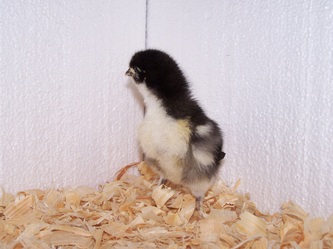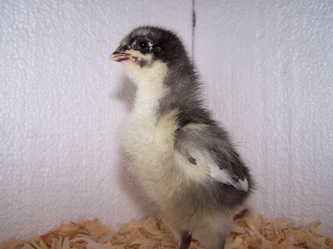Caring for baby chicks
Chicks are pretty easy to care for as long as they have protection, heat, food, water, and clean bedding.
Supplies:
Chick Brooder, cardboard box, or plastic tote
Heat
lamp
chick size waterier
chick feeder
bedding (pine shavings, or
synthetic bedding) I do not use anything that contains a scent as chickens have
very sensitive respiratory systems. Cedar shavings are also toxic, and can cause
respiratory problems you may not see until they get older.
Also, when my chicks are first born I line a plastic tote with newspaper, (pet potty training pads also work great) and then ad an layer of paper towels. I line the surface with paper towels because when the chicks
are first born they cannot be on a slippery surface area like newspaper because
it will cause developmental problems with their legs.
Keep the heat at 95 degrees the first week, and then lower the heat by 5 degrees every week until
they become fully feathered.
Just as chicks need heat, also please be careful not to overheat them. Watch for signs of overheating. (Chicks scattered as far away from heat source as if they are trying to avoid the heat and breathing
heavy from the mouth) If you see this, either raise the height of the heat lamp,
or lower the wattage of the bulb.
Pictured below our current brooding boxes
Chicks are pretty easy to care for as long as they have protection, heat, food, water, and clean bedding.
Supplies:
Chick Brooder, cardboard box, or plastic tote
Heat
lamp
chick size waterier
chick feeder
bedding (pine shavings, or
synthetic bedding) I do not use anything that contains a scent as chickens have
very sensitive respiratory systems. Cedar shavings are also toxic, and can cause
respiratory problems you may not see until they get older.
Also, when my chicks are first born I line a plastic tote with newspaper, (pet potty training pads also work great) and then ad an layer of paper towels. I line the surface with paper towels because when the chicks
are first born they cannot be on a slippery surface area like newspaper because
it will cause developmental problems with their legs.
Keep the heat at 95 degrees the first week, and then lower the heat by 5 degrees every week until
they become fully feathered.
Just as chicks need heat, also please be careful not to overheat them. Watch for signs of overheating. (Chicks scattered as far away from heat source as if they are trying to avoid the heat and breathing
heavy from the mouth) If you see this, either raise the height of the heat lamp,
or lower the wattage of the bulb.
Pictured below our current brooding boxes










































